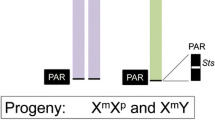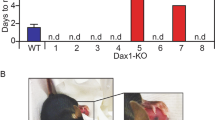Abstract
Accurate mouse sexing is vital when conducting research examining sexual dimorphisms. Late fetal and newborn mouse pups are more immature than many previously described sexing methods allow. This study compares the sexing accuracy of a newly described internal gonad sexing method to a recently described peritoneal pigmentation sexing method in embryonic day 20 C57BL/6J mouse pups, using Sry genotyping to confirm the sex. The internal gonad sexing method was found to be highly accurate, while the peritoneal pigmentation method was slightly less accurate. Therefore, while Sry genotyping remains the gold standard, immediate and less expensive sexing methods can be performed accurately as early as the late fetal period in C57BL/6J mice.





Similar content being viewed by others
References
Greenham, L.W. & Greenham, V. Sexing mouse pups. Lab. Anim. 11, 181–184 (1977).
Wolterink-Donselaar, I.G., Meerding, J.M. & Fernandes, C. A method for gender determination in newborn dark pigmented mice. Lab Anim. (NY) 38, 35–38 (2009).
Whyte, J.J., Roberts, R.M. & Rosenfeld, C.S. Fluorescent in situ hybridization for sex chromosome determination before and after fertilization in mice. Theriogenology 67, 1022–1031 (2007).
Cook, M. The Anatomy of the Laboratory Mouse (Academic Press Inc., New York, 1965).
Chen, H. et al. Identification of novel markers of mouse fetal ovary development. PLoS ONE 7, e41683 (2012).
Author information
Authors and Affiliations
Corresponding author
Ethics declarations
Competing interests
The authors declare no competing financial interests.
Rights and permissions
About this article
Cite this article
Deeney, S., Powers, K. & Crombleholme, T. A comparison of sexing methods in fetal mice. Lab Anim 45, 380–384 (2016). https://doi.org/10.1038/laban.1105
Received:
Accepted:
Published:
Issue Date:
DOI: https://doi.org/10.1038/laban.1105
- Springer Nature America, Inc.
This article is cited by
-
Large-scale labeling and assessment of sex bias in publicly available expression data
BMC Bioinformatics (2021)
-
Non-lethal sex identification of sea urchins: method and advantages
Lab Animal (2020)
-
Hematopoietic reconstitution of neonatal immunocompetent mice to study conditions with a perinatal window of susceptibility
Scientific Reports (2018)




